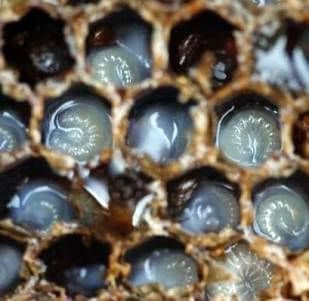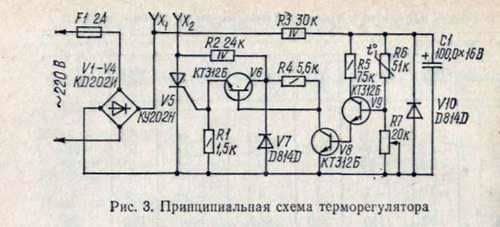
When keeping bees in insulated pavilions (taking into account the correct preparation of families), wintering usually passes successfully. But if the average temperature in the region in the winter months is relatively low, then the feed intake, and hence the filling of the intestines in bees in the pavilion by the spring, can be greater than that of their relatives living in a good winterhouse or in a pavilion with thermoregulation.
In most textbooks, the optimal temperature for wintering bees is from -2 to +2 њ C, and it was determined by the fact that at a given temperature in a winter hut the club of bees has minimal dimensions. This was based on the conclusion: the denser the club of bees, the less food they consume. It turned out that everything is not so.
The biological basis for the formation of the club is the lack of honey collection and a long drop in the temperature of the outside air to 8-10 њ C. It is known that in the autumn under such conditions the bees already form a club and go into a low-active state, the temperature most favorable for wintering in a beehive under the frames should be from 10 to 11 њ C, and in the wintering room – 7-8 њ C.
Now the exact studies confirmed: the least amount of energy the club of bees secretes at an ambient temperature of about 8 њ C, which means that this temperature corresponds to the lowest feed intake, the least filling of the intestine by spring, and the better keeping of bees in wintering, since the intake of food by the family is proportional to its energy release.
Obviously, the optimal temperature in the room for wintering bees can be maintained only with artificial heating.
The wintering of bees in warmed pavilions with electrical heating to a temperature of 2 to 4 њ C passes much better than in an unheated pavilion (without heating), and compared to beehives in a winter hut, bees spend less food and in spring such families are more powerful.
The results of all studies and the practice of many beekeepers-amateurs testify to the benefits and economic feasibility of electric heating of pavilions in the winter.
I tested two options for heating bee colonies (pavilion and hive) in a simple and affordable way. Its availability is determined by the absence of a need for a thermoregulator. In addition, heaters require low power, which ensures maximum fire safety and economy. Both versions can be justified by calculations and tested experimentally.
The point is that during the period of stable temperature reduction to -3-5 њ у, that is, approximately from the middle of November or early December, electric heaters of the same capacity are switched on, which is necessary to raise the temperature in the pavilion or in the hive by a given amount. The initial data for an approximate calculation of the required capacity of the heaters are the average monthly temperatures of the coldest months (taking into account the heat transfer of the walls, ceiling, floor of the pavilion or hive) and the necessary temperature increase from the electric heater.
The heat transfer of the pavilion or hive is equal to the sum of the heat transfer of the heat-conducting surfaces of the pavilion or hive, the number of which in general is equal to (each wall, ceiling and floor surfaces), and the removal of heat from air during ventilation is not taken into account.
The heat transfer of a single surface is defined as the product of the coefficient of thermal conductivity of a given surface by its area, and by the required temperature rise in Pavilion T њ (ie, T њ is equal to the specified temperature difference in the pavilion and on the street).
The optimal wintering temperature for bees, based on the minimum energy cost of the family, is in the range of 5 to 9 њ C for Central Russian bees from 4 to 6 њ C for gray mountain Caucasian bees, which is recommended to provide automatic temperature control in the pavilion. At the beginning of wintering, temperatures of 8-10 њ C are maintained for Central Russian bees, and no more than 4-5 њ C from the middle of February and in March (before flying) [10], with the presence of wide open lower tapes and complete absence of warming of hives.
This approach to determining the optimum temperature during wintering is more justified than recommendations to maintain the temperature in the winter hut from -2 њ C to + 2 њ C, which corresponds to the minimum size of the club, and not to the minimum energy expenditure of bees.
Only the minimum energy expenditure of the family corresponds to the most serene state of bees with the lowest feed intake and filling of the intestine, and consequently, with less wear and tear.
One should also take into account the important fact that at a temperature outside the hive from 3 to 8 њ C, bees freely move on honeycombs and can develop honey reserves in any direction. Proceeding from these conditions, and also taking into account that even with a short-term increase in temperature during the wintering period above 9-10 њ C, bees sharply increase the feed intake for a long period (up to several days, since they become active), we take as the temperature limit value in the pavilion in winter 9 њ у.
In the absence of automatic temperature control, it is necessary to take into account possible long-term average excesses in the course of warming. For the area of the apiary, this temperature is 1-2 њ C. Consequently, when the heater is constantly on, it is not permissible to raise the temperature in the pavilion by more than 7 њ C. After all, with the onset of warming, it can exceed 9 њ C.
As the experiment showed, 150 W was required to heat the pavilion in question.
If the pavilion has a large number of families (more than 8-10), it is necessary to take into account the thermal energy allocated by each family and equal in a period passive for bees with optimal wintering conditions of 5-8 W. With the indicated capacity of the heater at an average temperature of December, January, February and March – 6.6 њ C, – 8.5 њ C, – 9.2 њ C and -5.5 њ C, respectively, the temperature in the pavilion is maintained for most of the winter from -4 њ у to + 4 њ у, and with warming in the street to 1-2 њ у it becomes equal to 8-9 њ у, which allows bees to expand the club and freely move on honeycombs for development of honey reserves.
The existing discrepancies between the outside temperature and the temperature in the pavilion are explained by sharp changes in the weather at that time and by the thermal inertia of the pavilion.
In March, when the temperature in the pavilion rises to 6-7 њ C, the heater must be switched off.
After flying over the bees (if there are honey reserves, perga in the beehives, and providing water in individual drinkers), it is possible to include the same or more powerful heater, designed to increase the temperature in the pavilion by 16-18 њ C, and keep it turned on until steady warming, not allowing a rise in temperature in the pavilion above 25-28 њ C.
The considered method of raising the temperature in a small pavilion, when 4-5 families of bees winter, requires 300-330 kWh of electricity, which can be considered quite justified economically. Bees spend less honey, save for better spring development.
Significantly more economical in general is a similar way of maintaining the necessary microclimate in the hive. Calculations and experiments show that in order to raise the temperature by 7 њ C in a single hive with external insulation, a power of 4-5 W is sufficient. With a much lower power consumption, the temperature stability with this heating method is significantly lower due to the low thermal inertia of the hive.
Electric heaters used to heat the pavilion are of different designs. One of the main requirements for them is fire safety provided by reliable electrical insulation and contacts, low-temperature heaters having, at constant switching on, the temperature of the open parts is not higher than 80-90 њ у. Spirals should be of a closed type. Heaters are installed taking into account the fulfillment of all fire regulations, at a distance of not less than 1.5 m from grounded items. The power of heaters included in one household outlet should not exceed 250-300 watts. If it is above the specified heaters, then use wire, sockets and plugs for the power circuits.
Heaters in the hive, located under the honeycombs, must be protected from falling on them crumbling wax crumbs, scum and other waste from the club of bees, in order to avoid the ignition of debris.
From the automatic temperature control systems in the pavilion and in the hive I checked the circuit. In this scheme, to reduce the heating of resistors R2 and R3, it is necessary to increase their power to 4 W by parallel switching of two 2 W resistors with 47 and 62 kOhm ratings, respectively.
To connect heaters with a power of up to 0.5-0.6 kW, the area of the radiators for power diodes and thyristors must be increased to 80-100 cm2. The absence of transformers and relays makes such circuits reliable and safe.
With automatic temperature control, it is not advisable to use heaters with a large margin of power. Sufficient is that which is only 2-3 times higher than the design value for a heater without autoregulation, that is 300-400 W.
As an optimal option, we can recommend a permanently switched on heater, designed to heat the pavilion at 6-7 њ C, and an additional one, 1.5-2 times larger, automatically turned on when the temperature in the pavilion drops to -2 њ C.

For unregulated heating of the pavilion, I use a low-temperature heater with a closed spiral, consisting of four series-connected elements, each of which has 2 ceramic bases from a conventional electric plate. A helix with a power of 600 W is laid in one base, and the second one closes.
The assembled elements are fastened to a metal frame with a thickness of 2-3 mm and an area of 0.2-0.25 m2, and they are electrically connected using heat-resistant mounting wires and screw contacts. The total power of this heater is about 150 watts. The temperature of the ceramic surface with constant inclusion does not exceed 60-70 њ C.
Определение падевого меда. Можно давать муку пчелам.
Contents of bees in the pavilion